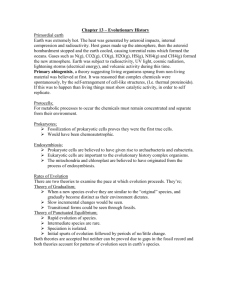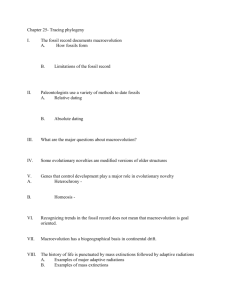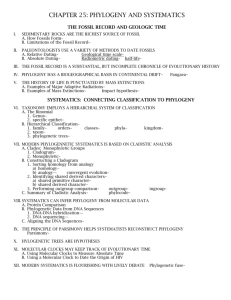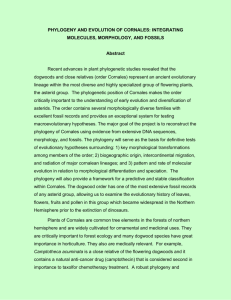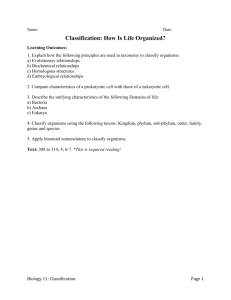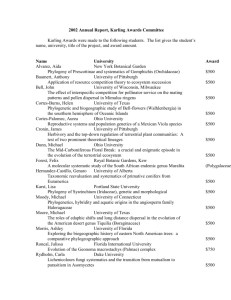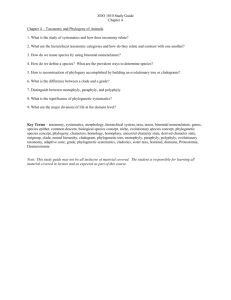Animal Classification, Phylogeny and Organization
advertisement
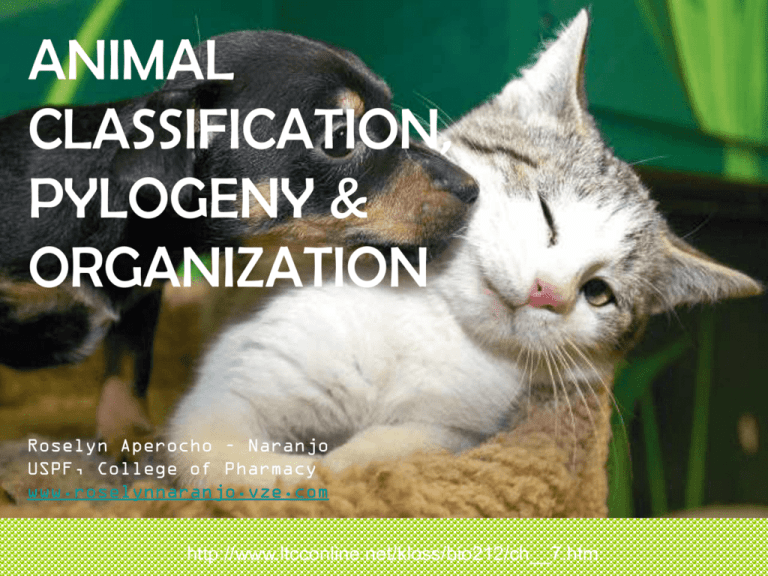
ANIMAL CLASSIFICATION, PYLOGENY & ORGANIZATION Roselyn Aperocho – Naranjo USPF, College of Pharmacy www.roselynnaranjo.vze.com http://www.ltcconline.net/kloss/bio212/ch__7.htm Animal Classification, Phylogeny and Organization Introduction A. Biologists have named and described more than 1.4 million species B. More than .75 of these are animals C. Many zoologists group organisms by shared characteristics 1. these shared characteristics are a consequence of shared evolutionary processes 2. these groupings reflect order found in living systems 3. there are still 4 - 30 million undescribed species, lots of work left Animal Classification, Phylogeny and Organization Introduction A. Biologists have named and described more than 1.4 million species B. More than .75 of these are animals C. Many zoologists group organisms by shared characteristics 4. There are 36 different animal phyla, the highest taxon under the kingdom level 5. the most recently discovered animal phylum was designated in 1995 by Kirstensen and Funch in Denmark - Cycliophora Animal Classification, Phylogeny and Organization Introduction Cycliophora Animal Classification, Phylogeny and Organization Classification of Organisms 1. Language helps us to communicate, but also to encode and classify concepts, objects and organisms 2. To name organisms just by species names does not help us much 3. A classification system reflects the order and relationships that arise from evolutionary processes 4. The study of the diversity among organisms, the evolutionary relationships among them is called systematics; taxonomy is the naming and classifying of organisms Animal Classification, Phylogeny and Organization Classification of Organisms 5. These studies result in description of new species and org of animals into groups (taxa) based on evolutionary relatedness 6. Nomenclature is the assigning of a distinctive name to each species Animal Classification, Phylogeny and Organization Taxonomic hierarchy 1. Karl von Linne - Carolus Linnaeus - 1707-1778 instituted binomial system we use today 2. grouped different species into broader categories based on shared characteristics 3. A grouping of animals that shares characteristics is called a taxon - kpcofgs. Animal Classification, Phylogeny and Organization Taxonomic hierarchy taxon - kpcofgs a. housefly shares 1 pr wings w/ all true flies – same genus b. share other characteristics with bees, butterflies, beetles - all are insects c. above spp. level, definitions of what forms taxon are not precise - lots of arguments d. ideally, members of same taxon are more closely related genetically than w/others not in taxon Animal Classification, Phylogeny and Organization Nomenclature 1. binomial nomenclature adds precision to names of organisms 2. common names vary from city to city, country to country 3. common names often designate genera, not species 4. no other animal or organism has the same binomial nomenclature 5. genus is capitalized, species is lowercase; both are italicized or underlined, separately Animal Classification, Phylogeny and Organization D. Molecular approaches to systematics 1. molecular bio has provided important info for taxonomy of plants and animals 2. relatedness of particular organisms is reflected in shared DNA sequences, as well as in protein products 3. genes and proteins from related animals are more similar than genes and proteins from distantly related animals 4. since mutation rate is constant, a relationship to frequency of cell division, taxonomists can ascertain the length of time since divergence from a common ancestor Animal Classification, Phylogeny and Organization D. Molecular approaches to systematics 5. using mitochondria in eukaryotes involves relatively small quantities of DNA that change at a relatively constant rate 6. this is called a molecular clock 7. molecular clocks run at difft rates depending on if you are looking at DNA, RNA, protein, etc Animal Classification, Phylogeny and Organization E. Kingdoms of Life 1. Whittaker - 1969 - described 5 kingdoms based on cellular organization and mode of nutrition Animal Classification, Phylogeny and Organization MONERA E. Kingdoms of Life Cell: •not enclosed in a distinct nuclear membrane •Very small in size (about 1 micrometer) •may be arranged in rows or in clusters ) •can survive unfavorable conditions such as extreme dryness or heat by producing an extra spore coat. •can be round, rodshaped, or spiral-shaped •can be round, rodshaped, or spiral-shaped Reproduction: reproduce through binary fission (asexual) or conjugation (sexual) Animal Classification, Phylogeny and Organization MONERA E. Kingdoms of Life Respiration: •obligate aerobes, the prokaryotes must have oxygen to live •obligate anaerobes, the organisms cannot survive in the presence of oxygen • facultative anaerobes they can survive with or without oxygen. Digestion: extracellular (outside the cell) and nutrients are absorbed into the cell Animal Classification, Phylogeny and Organization MONERA E. Kingdoms of Life Circulation: • accomplished through diffusion Nutritional Diversity: •Autotrophs manufacture their own organic compounds • Heterotrophs obtain their energy by feeding on other organic substances • Saprophytes, a special kind of heterotroph, obtain energy by feeding on decaying matter Animal Classification, Phylogeny and Organization FUNGI E. Kingdoms of Life • are unicellular or filamentous. • their body is prepared by the mycelium that comprise the thread like hyphae. • Mycelium appears like the web of spider. • Walls of most of the hyphae are made up of chitin and cellulose. • Number of nuclei in the cells may be one, two or more. • they do not have chlorophyll and starch in their cells. • Glycogen is the reserve food. Animal Classification, Phylogeny and Organization FUNGI E. Kingdoms of Life Animal Classification, Phylogeny and Organization PROTISTA E. Kingdoms of Life euglena • Protista have simple unicellular, colonial and eukaryotic organization. • There are true nucleus and membrane bound other cell organelles, cytoplasmic streaming and sap vacuoles. • Locomotion is generally present. • It occurs with the help of flagella and pseudopodia. • Animal Classification, Phylogeny and Organization PROTISTA • • • • • E. Kingdoms of Life Some protista are covered with cell wall while others do not posses it. It is diverse photosynthetic holozoic. Photosynthetic nutrition occurs in unicellular algae euglena like organisms. Organisms with mixotrophic nutrition are called as plant-animals. Sexual reproduction is present but an embryo stage is absent. Animal Classification, Phylogeny and Organization PROTISTA E. Kingdoms of Life Animal Classification, Phylogeny and Organization PLANTAE E. Kingdoms of Life • Plants are living organisms which cannot move and prepares their food themselves by the process of photosynthesis • Plant kingdom includes trees, shrebs, herbs, grasses, ferns, bushes etc.,. Some of the nourishment that is needed to our body is provided by plants. • Plant Kngdom was originally proposed by Linnaeus Animal Classification, Phylogeny and Organization PLANTAE E. Kingdoms of Life Bryophytes Pteridophytes Gymnosperms Angiosperms Monocotyledons Dicotyledons Animal Classification, Phylogeny and Organization PLANTAE E. Kingdoms of Life Bryophytes These are the simple land plants without leaves and roots. They have hair like structures called Rhizoids to hold the surface. They need water for fertilization. Embryo forms after fertilization. Eg. Moses. We can find Bryophytes growing on rocks, soil and on trees. Animal Classification, Phylogeny and Organization PLANTAE E. Kingdoms of Life Pteridophytes In these plant body contains stem, roots and leaves. Vascular system is present. Fertilized egg becomes embryo. Animal Classification, Phylogeny and Organization PLANTAE E. Kingdoms of Life Gymnosperms Stem is erect and have branches. Reproduction is sexual. Leaves are photosynthetic. Gametophytes are very reduced in their size. These are the first seeded plants. The literal meaning of Gymnosperms is Naked Seed. Animal Classification, Phylogeny and Organization PLANTAE E. Kingdoms of Life Gymnosperms Animal Classification, Phylogeny and Organization PLANTAE E. Kingdoms of Life Angiosperms Monocotyledons Have only one cotyledon in the seed. Eg., wheat, maize and paddy. Dicotyledons Have two cotyledons in the seed. Eg., Ground nut, Bean Pea. Animal Classification, Phylogeny and Organization PLANTAE E. Kingdoms of Life Animal Classification, Phylogeny and Organization ANIMALIA E. Kingdoms of Life Characteristics: 1. Animals are heterotrophic, meaning they depend on other organisms for food. Unlike plants and other photosynthetic organisms, animals do not contain chlorophyll that is essential in food production. 2. All animals are multicellular. Their cells are highly specialized to perform specific functions, such as digestion, movement, reproduction, and excretion. Animal Classification, Phylogeny and Organization ANIMALIA E. Kingdoms of Life Characteristics: 3. Animal cells are eukaryotic, meaning they have a welldefined nucleus. They also have membrane-bound organelles. 4. Many animals are motile. They move from place to place in search of food, mate, a better place to live, and to avoid danger. 5. Most animals exhibit sexual reproduction. Each individual grows from a fertilized egg and passes through various distinct stages of embryonic development. Animal Classification, Phylogeny and Organization E. Kingdoms of Life 2. Ribosomal RNA is pretty constant, doesn’t change much- exhibits evolutionary conservation can’t mess too much w/ protein making mechanism 3. biologists compare ribosomal RNA of different organisms to find how sequences are different. 4. look at all possible arrangement and figure out which arrangement best explains data 5. Studies of ribosomal RNA indicates that there are 3 main evolutionary lineages - domains Animal Classification, Phylogeny and Organization E. Kingdoms of Life 6. domains (Bacteria, Archaea, Eukarya) are broadest taxonomic grouping a. archaea - all anaerobic, from hostile environments b. Archaeans gave rise to bacteria - true bacteria = eubacteria, prokaryotic c. eubacteria diverged first from archaea, then eukarya diverged. So all eukaryotes are more closely related to archaea than eubacteria Animal Classification, Phylogeny and Organization F. Animal SYstematics 1. goal is to arrange animals into groups that reflect evolutionary relationships 2. groups should include ancestral species and all descendants - monophyletic group 1. molecular traits - e.g. DNA sequence 2. anatomical features - e.g. bones in forelimbs 3. monophyletic group - includes ancestor and all descendants 4. paraphyletic group - includes some but not all members of a lineage Animal Classification, Phylogeny and Organization F. Animal SYstematics 1. goal is to arrange animals into groups that reflect evolutionary relationships 2. groups should include ancestral species and all descendants - monophyletic group 5. polyphyletic group - members that can be traced to a different lineage 6. 3 different schools have developed due to disagreements on whether data may be used to describe distant evolutionary relationships, and methods of investigation Animal Classification, Phylogeny and Organization F. Animal SYstematics distant evolutionary relationships/ methods of investigation a. evolutionary systematics - "traditional approach" 1. basic assumption - organisms more closely related to an ancestor will resemble the ancestor more than they resemble distantly related organisms 2. homology vs. analogy a) analogies often develop in response to similar selective pressures convergent evolution 3. work often portrayed in phylogenetic trees Animal Classification, Phylogeny and Organization F. Animal SYstematics distant evolutionary relationships/ methods of investigation b. numerical taxonomy - believed criteria for traditional systematics had become too arbitrary and vague 1. objectivity - mathematical models, computer aided techniques to group samples of organisms according to overall similarity 2. do not attempt to distinguish homology and analogy - data will overshadow and correct 3. limit discussions of ancestry to closely related taxa 4. least popular of all the schools Animal Classification, Phylogeny and Organization F. Animal SYstematics distant evolutionary relationships/ methods of investigation c. phylogenetic systematics - also called cladistics 1. goal is to generate hypotheses of ancestry among monophyletic groups 2. they argue that their methods are more objective than traditional approach 3. use analogy and homology, but are most interested in homologies of recent origin 4. character shared by all members of a group is called symplesiomorphy Animal Classification, Phylogeny and Organization F. Animal SYstematics distant evolutionary relationships/ methods of investigation c. phylogenetic systematics - also called cladistics 5. to decide what character is ancestral to a group of organisms, they pick a related group called the outgroup a. characters that have arisen since common ancestry with the outgroup are called synapomorphies or derived characters 6. cladogram is a family tree depicting a hypothesis of regarding monophyletic lineages Animal Classification, Phylogeny and Organization F. Animal SYstematics distant evolutionary relationships/ methods of investigation c. phylogenetic systematics - also called cladistics 7. cladogram, traditional groupings on top; see bird/reptile relationships a. generations of taxonomists have assigned class level status to birds b. reptiles have also had class status c. birds more closely related to alligators and crocs than other reptiles; d. grouping should reflect this e. trad. maintain correctness, bc feathers are important traits to distinguish them, cladistics maintains that value judgments have no place here f. this is part of science, and what drives investigation VIDEO PRESENTATION Biological Classification: Kingdoms
